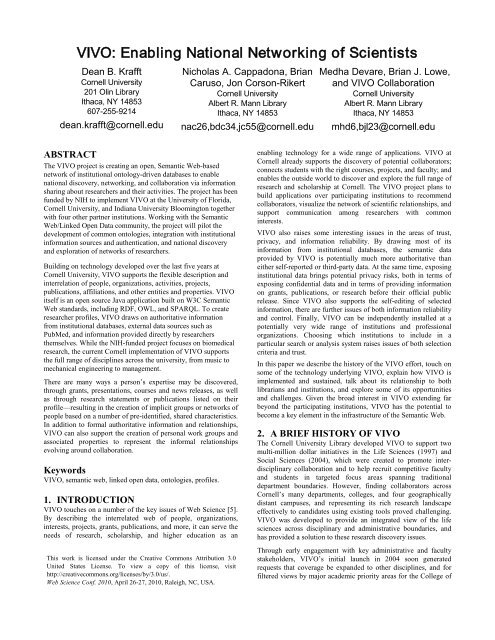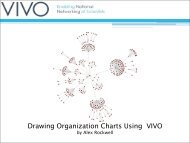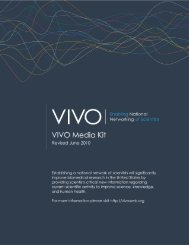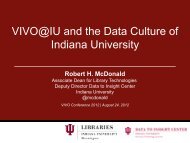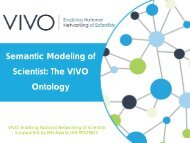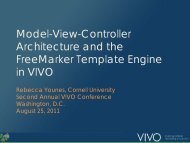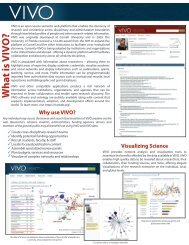Enabling National Networking of Scientists - VIVO
Enabling National Networking of Scientists - VIVO
Enabling National Networking of Scientists - VIVO
You also want an ePaper? Increase the reach of your titles
YUMPU automatically turns print PDFs into web optimized ePapers that Google loves.
<strong>VIVO</strong>: <strong>Enabling</strong> <strong>National</strong> <strong>Networking</strong> <strong>of</strong> <strong>Scientists</strong>Dean B. KrafftCornell University201 Olin LibraryIthaca, NY 14853607-255-9214dean.krafft@cornell.eduNicholas A. Cappadona, BrianCaruso, Jon Corson-RikertCornell UniversityAlbert R. Mann LibraryIthaca, NY 14853nac26,bdc34,jc55@cornell.eduMedha Devare, Brian J. Lowe,and <strong>VIVO</strong> CollaborationCornell UniversityAlbert R. Mann LibraryIthaca, NY 14853mhd6,bjl23@cornell.eduABSTRACTThe <strong>VIVO</strong> project is creating an open, Semantic Web-basednetwork <strong>of</strong> institutional ontology-driven databases to enablenational discovery, networking, and collaboration via informationsharing about researchers and their activities. The project has beenfunded by NIH to implement <strong>VIVO</strong> at the University <strong>of</strong> Florida,Cornell University, and Indiana University Bloomington togetherwith four other partner institutions. Working with the SemanticWeb/Linked Open Data community, the project will pilot thedevelopment <strong>of</strong> common ontologies, integration with institutionalinformation sources and authentication, and national discoveryand exploration <strong>of</strong> networks <strong>of</strong> researchers.Building on technology developed over the last five years atCornell University, <strong>VIVO</strong> supports the flexible description andinterrelation <strong>of</strong> people, organizations, activities, projects,publications, affiliations, and other entities and properties. <strong>VIVO</strong>itself is an open source Java application built on W3C SemanticWeb standards, including RDF, OWL, and SPARQL. To createresearcher pr<strong>of</strong>iles, <strong>VIVO</strong> draws on authoritative informationfrom institutional databases, external data sources such asPubMed, and information provided directly by researchersthemselves. While the NIH-funded project focuses on biomedicalresearch, the current Cornell implementation <strong>of</strong> <strong>VIVO</strong> supportsthe full range <strong>of</strong> disciplines across the university, from music tomechanical engineering to management.There are many ways a person’s expertise may be discovered,through grants, presentations, courses and news releases, as wellas through research statements or publications listed on theirpr<strong>of</strong>ile—resulting in the creation <strong>of</strong> implicit groups or networks <strong>of</strong>people based on a number <strong>of</strong> pre-identified, shared characteristics.In addition to formal authoritative information and relationships,<strong>VIVO</strong> can also support the creation <strong>of</strong> personal work groups andassociated properties to represent the informal relationshipsevolving around collaboration.Keywords<strong>VIVO</strong>, semantic web, linked open data, ontologies, pr<strong>of</strong>iles.1. INTRODUCTION<strong>VIVO</strong> touches on a number <strong>of</strong> the key issues <strong>of</strong> Web Science [5].By describing the interrelated web <strong>of</strong> people, organizations,interests, projects, grants, publications, and more, it can serve theneeds <strong>of</strong> research, scholarship, and higher education as anThis work is licensed under the Creative Commons Attribution 3.0United States License. To view a copy <strong>of</strong> this license, visithttp://creativecommons.org/licenses/by/3.0/us/.Web Science Conf. 2010, April 26-27, 2010, Raleigh, NC, USA.enabling technology for a wide range <strong>of</strong> applications. <strong>VIVO</strong> atCornell already supports the discovery <strong>of</strong> potential collaborators;connects students with the right courses, projects, and faculty; andenables the outside world to discover and explore the full range <strong>of</strong>research and scholarship at Cornell. The <strong>VIVO</strong> project plans tobuild applications over participating institutions to recommendcollaborators, visualize the network <strong>of</strong> scientific relationships, andsupport communication among researchers with commoninterests.<strong>VIVO</strong> also raises some interesting issues in the areas <strong>of</strong> trust,privacy, and information reliability. By drawing most <strong>of</strong> itsinformation from institutional databases, the semantic dataprovided by <strong>VIVO</strong> is potentially much more authoritative thaneither self-reported or third-party data. At the same time, exposinginstitutional data brings potential privacy risks, both in terms <strong>of</strong>exposing confidential data and in terms <strong>of</strong> providing informationon grants, publications, or research before their <strong>of</strong>ficial publicrelease. Since <strong>VIVO</strong> also supports the self-editing <strong>of</strong> selectedinformation, there are further issues <strong>of</strong> both information reliabilityand control. Finally, <strong>VIVO</strong> can be independently installed at apotentially very wide range <strong>of</strong> institutions and pr<strong>of</strong>essionalorganizations. Choosing which institutions to include in aparticular search or analysis system raises issues <strong>of</strong> both selectioncriteria and trust.In this paper we describe the history <strong>of</strong> the <strong>VIVO</strong> effort, touch onsome <strong>of</strong> the technology underlying <strong>VIVO</strong>, explain how <strong>VIVO</strong> isimplemented and sustained, talk about its relationship to bothlibrarians and institutions, and explore some <strong>of</strong> its opportunitiesand challenges. Given the broad interest in <strong>VIVO</strong> extending farbeyond the participating institutions, <strong>VIVO</strong> has the potential tobecome a key element in the infrastructure <strong>of</strong> the Semantic Web.2. A BRIEF HISTORY OF <strong>VIVO</strong>The Cornell University Library developed <strong>VIVO</strong> to support twomulti-million dollar initiatives in the Life Sciences (1997) andSocial Sciences (2004), which were created to promote interdisciplinarycollaboration and to help recruit competitive facultyand students in targeted focus areas spanning traditionaldepartment boundaries. However, finding collaborators acrossCornell’s many departments, colleges, and four geographicallydistant campuses, and representing its rich research landscapeeffectively to candidates using existing tools proved challenging.<strong>VIVO</strong> was developed to provide an integrated view <strong>of</strong> the lifesciences across disciplinary and administrative boundaries, andhas provided a solution to these research discovery issues.Through early engagement with key administrative and facultystakeholders, <strong>VIVO</strong>’s initial launch in 2004 soon generatedrequests that coverage be expanded to other disciplines, and forfiltered views by major academic priority areas for the College <strong>of</strong>
Agriculture and Life Sciences, and this was accomplished in 2005[4]. In 2007 the Office <strong>of</strong> the Provost committed funding to theLibrary to expand the scope <strong>of</strong> <strong>VIVO</strong> to the entire university.This funding has supported the development <strong>of</strong> an interactiveediting tool and web services to facilitate data sharing from <strong>VIVO</strong>to other websites and information consumers at Cornell. Rapidexpansion <strong>of</strong> content scope made it essential to go beyond manualcontent acquisition and to tap other sources <strong>of</strong> informationincluding external publications databases and Cornelladministrative systems <strong>of</strong> record. By working closely withmanagers and IT staff, <strong>VIVO</strong> is now able to integrate regularfeeds from the human resources system (Peoples<strong>of</strong>t), thesponsored research (grants) database, the course database,publications databases, and faculty reporting systems for severalCornell colleges. Thus, appropriate publicly-visible data ismapped into <strong>VIVO</strong> from a variety <strong>of</strong> authoritative sources asupdates that require no additional effort by faculty.An informal network <strong>of</strong> department, research center, and corefacilities staff has also volunteered to review and update content,and individuals wishing to update information themselves can login via Cornell’s single sign-on to supplement the information fromsystems <strong>of</strong> record. <strong>VIVO</strong> not only supports a public search andbrowse interface, but it provides an integrated source <strong>of</strong> richinformation to supplement Cornell websites focused oninternational activities, graduate student recruitment, and campuswideinitiatives in entrepreneurship.<strong>VIVO</strong> was originally designed as an ontology implemented in arelational database, but one which emulated Semantic Webprinciples and presented the relationships among the people,departments, grants, publications, and events at Cornell as aprimary feature <strong>of</strong> the interface. By 2007 improvements to WebOntology Language 1 (OWL) and Resource DescriptionFramework 2 (RDF) tools, including Java libraries to manage largeRDF models, the SPARQL query language 3 , and improvedreasoners, made it clear that <strong>VIVO</strong> would be both more flexibleand more sustainable if converted to read and write OWLontologies and RDF data. This conversion was accomplished [3],and it has enabled <strong>VIVO</strong> to fit into a much larger ecosystem <strong>of</strong>tools, as well as helping to ensure that data will not be locked inas standards continue to evolve. The emergence <strong>of</strong> the LinkedOpen Data 4 movement provides an opportunity for aggregatingdata from <strong>VIVO</strong> installations at multiple institutions withoutrequiring a centralized database or support structure.In September 2009 the <strong>National</strong> Center for Research Resources(NCRR) <strong>of</strong> the <strong>National</strong> Institutes <strong>of</strong> Health (NIH) provided agrant <strong>of</strong> $12.2 million to develop and implement a new version <strong>of</strong><strong>VIVO</strong> to enable national networking <strong>of</strong> scientists. Led by theUniversity <strong>of</strong> Florida, the <strong>VIVO</strong> team consists <strong>of</strong> CornellUniversity and Indiana University Bloomington as leaddevelopment partners, with Weill Cornell Medical College, theWashington University at St. Louis School <strong>of</strong> Medicine, TheScripps Research Institute, and Ponce School <strong>of</strong> Medicine asimplementation partners. The remainder <strong>of</strong> this paper describeshow we propose to accomplish this goal, and some <strong>of</strong> thechallenges and opportunities involved.3. THE <strong>VIVO</strong> TECHNOLOGY<strong>VIVO</strong> is an application built on Semantic Web technologies thatcombines a web-based ontology and instance editor, contentintegration tools, and a lightweight content management system.The <strong>VIVO</strong> core ontology provides the framework to modelscientists and their activities in a consistent manner. The <strong>VIVO</strong>data ingest tools enable populating the ontology from a range <strong>of</strong>local and national data sources, while the self-editing interfaceallows end users to supplement standard sources. <strong>VIVO</strong>’s contentmanagement system provides site curators additional control overthe information architecture and display features as well asbranding. Via the Linked Data standard, <strong>VIVO</strong> can be connectedto the rest <strong>of</strong> the Semantic Web and the range <strong>of</strong> servicesinteroperating on it.<strong>VIVO</strong> is implemented as a Java web application, and the currentrelease <strong>of</strong> <strong>VIVO</strong> is designed to run in a Tomcat 5 servlet container.<strong>VIVO</strong> supports OWL ontologies, which are represented in thesystem at runtime as Jena 6 object models. These ontologies caneither be developed using an external editor, such as Protégé 7 , orthey can be developed within <strong>VIVO</strong> itself. Section 4 describes thespecifics <strong>of</strong> the <strong>VIVO</strong> ontology.Once the standard <strong>VIVO</strong> ontology is loaded, with possible localextensions, it can be populated either by direct entry and editingthrough an administrative interface, or information can be loadedin batch from sources <strong>of</strong> record within the institution. In additionto directly entered instances, the system uses a Pelletcreate selected inferences from the available data. The level <strong>of</strong>inferencing can be selected in the <strong>VIVO</strong> configuration.Once the data is available, <strong>VIVO</strong> creates a public web site, withpages showing pr<strong>of</strong>ile information and affiliations for individuals,and membership, affiliations, and other information fororganizational units. Information display is theme-driven and fully9customizable. Site information is indexed using Lucene , and thesite is fully searchable.<strong>VIVO</strong> supports authenticated self-editing <strong>of</strong> a subset <strong>of</strong> theinformation about an individual. This allows, for example, facultyto upload images, refer to their personal or project web sites, andprovide a research statement or a list <strong>of</strong> research interests.10Authentication can be through Shibboleth or some otherinstitutional single sign-on system.Starting in mid-April 2010, the latest version <strong>of</strong> the <strong>VIVO</strong>s<strong>of</strong>tware, ontology, and documentation will be available fordownload at http://www.vivoweb.org. The <strong>VIVO</strong> s<strong>of</strong>tware islicensed under a standard open-source BSD license.5 http://tomcat.apache.org/8reasoner to6 http://jena.sourceforge.net/1 http://www.w3.org/TR/owl-features/2 http://www.w3.org/RDF/3 http://www.w3.org/TR/rdf-sparql-query/4 http://linkeddata.org7 http://protege.stanford.edu/8 http://clarkparsia.com/pellet/9 http://lucene.apache.org/java/docs/index.html10 http://shibboleth.internet2.edu/
4. THE <strong>VIVO</strong> ONTOLOGYAll data in <strong>VIVO</strong> are represented as RDF statements using classesand properties from OWL ontologies. These ontologies specifythe types <strong>of</strong> resources described in <strong>VIVO</strong> and their relationships.The project is developing a <strong>VIVO</strong> core ontology to model thepeople, organizations, and activities involved in scientific researchas a collaborative endeavor <strong>of</strong> the seven partner institutions. Inkeeping with the spirit <strong>of</strong> linked data, the <strong>VIVO</strong> core ontologyextends existing ontologies such as the Friend-<strong>of</strong>-a-Friend(FOAF) ontology 11 , which provides the basis for describingpersons and organizations, and the Bibliographic Ontology(BIBO) 12 , which models documents such as books and journalarticles. The <strong>VIVO</strong> project will identify additional ontologies notdirectly extended by the core ontology that are likely candidatesfor interoperability. Mappings to these ontologies will enable<strong>VIVO</strong> data to be shared among a variety <strong>of</strong> systems.While all institutional installations <strong>of</strong> <strong>VIVO</strong> share the coreontology, each institution is free to extend this ontology or addadditional ontologies as desired. The core ontology is not aconstraining schema that prescribes the data that may be enteredinto <strong>VIVO</strong>. Instead, it serves as an integration layer that permitsdata from different institutions to be queried in a consistent way.Individual installations may extend the core with ontologies thatreflect available data sources or which model things that may beimportant to display locally but are not necessary for aggregationat the national level. Differences in institutional structure may alsobe modeled. For example, librarians at one institution may bemembers <strong>of</strong> the faculty while librarians at a second are not: thecore Librarian class may be extended in local ontologies torepresent this. These local ontology additions can be created inthe <strong>VIVO</strong> s<strong>of</strong>tware’s built-in ontology editor as well as by loadingOWL ontologies made by other tools or found on the Web.A significant challenge in developing the core ontology is toinclude enough detail to allow for meaningful cross-site discovery<strong>of</strong> data, while keeping it simple enough to apply to very diverseacademic and clinical institutions. There is a limit to what can beanticipated in advance, and it is expected that the core ontologywill evolve in response to the RDF data that is ingested into localinstallations. Another factor that complicates the <strong>VIVO</strong> coreontology is the need to track how a researcher’s affiliations andactivities change throughout his or her career. Employmentrelationships, for example, may be represented by a simpleproperty relating persons to organizations. The <strong>VIVO</strong> coreontology, however, models employment as a resource that isrelated not only to a person and an organization but which canhave additional properties describing the date that employmentrelationship began and the date when it ended. While this is awell-understood technique for modeling complex relationships 13 ,it is not especially convenient for applications interested only incurrent relationships. We plan to add a simple property linkingpersons directly to those organizations in which they are currentlyemployed; the values <strong>of</strong> this property would be populatedautomatically by a query <strong>of</strong> the complex relationships.While the <strong>VIVO</strong> ontology was based on the ontology used inCornell University’s existing implementation, the <strong>VIVO</strong> project11 http://www.foaf-project.org/12 http://bibliontology.com/13 http://www.w3.org/TR/swbp-n-aryRelationshas been working hard to generalize it to meet the diverse needs<strong>of</strong> the <strong>VIVO</strong> partners. With the public release <strong>of</strong> the ontology inmid-April 2010, we will be seeking extensive outside review andcomment. Our goal is to create a core <strong>VIVO</strong> ontology that canserve as the base for describing individuals and their affiliations atany higher-education or research-focused institution.5. LIBRARIAN DRIVENThe academic library is a strong resource for informationtechnology expertise and information management anddissemination at any institution. Further, it tends to be a neutraland trusted entity, with employees who regularly engage withresearchers and have a good understanding <strong>of</strong> the academiclandscape and the needs <strong>of</strong> the research community. Theseattributes make the institutional library an ideal driver for the<strong>VIVO</strong> project. As has already been noted, <strong>VIVO</strong> was developedwithin the Cornell University Library, and librarians have playeda critical role in its development, growth, and adoption. Thissuccessful model is being broadened to other institutions withinthe <strong>VIVO</strong> project consortium, and libraries will play a central rolein a variety <strong>of</strong> areas including content development, supportprovision, and outreach to foster adoption.Librarians are increasingly being hired with MS and PhDcredentials as subject experts with intimate knowledge <strong>of</strong> howresearch is conducted and the ways in which the business <strong>of</strong>research might be better supported through information-relatedsolutions. Medical librarians in particular are involved intranslational research efforts as well as in instruction in efforts tobridge the “bench to bedside” gap.Librarian expertise and knowledge is being brought to bear inguiding the development <strong>of</strong> features, content types and entry, andthe appropriate context for institutional implementations <strong>of</strong><strong>VIVO</strong>. The ontology team includes librarians to ensure that thecore ontology appropriately models content types <strong>of</strong> importance inthe research and clinical setting. Implementation teams at eachinstitution include librarians in lead or key roles, to informcustomization that will more accurately reflect the local scenario,and to provide installation and use feedback to developers.Although much <strong>of</strong> the data in <strong>VIVO</strong> pr<strong>of</strong>iles is populated viaautomated feeds, initial data entry and testing to refine contentcategories in the <strong>VIVO</strong> interface tends to be manual, and managedby librarians.Work with <strong>VIVO</strong> at Cornell has demonstrated that deliveringtechnical capability alone is not sufficient to ensure adoption andusage by either the individual or the institution. For successfuladoption, technical innovation must be backstopped by humanfacilitation—in this instance, by information specialists frominstitutional libraries. Our assumption is that researcherengagement and outreach by information specialists will promoteadoption, usage, and maintenance <strong>of</strong> <strong>VIVO</strong> by the researchcommunities in their institutions. The liaison programs already inplace at many academic libraries mean that librarians already havethe proven capability <strong>of</strong> engaging with their users, with medicallibrarians involved in translational efforts <strong>of</strong>ten being at theforefront <strong>of</strong> such engagement.Good knowledge <strong>of</strong> user communities and their information needsmeans that librarians recognize that the motivations for diverseuser groups in utilizing <strong>VIVO</strong> are <strong>of</strong>ten different. For instance,while the possibility <strong>of</strong> finding potential collaborators via <strong>VIVO</strong>may in itself be a motivator for scientists, clinicians who do not
depend on such tools to “draw business” may be less enthusiastic.Administrators are motivated by yet other functionalities,including the need to quickly find experts in a given area.Similarly, Rogers [6] typified technology adopters by theiropenness to new technology as innovators (who tend to beinterested in the technology itself and quick to test and adopt newtools), the early adopters (who are willing to experiment andenthusiastic users <strong>of</strong> technology), the early majority (who waitand evaluate a technology before adopting it), the late majority(who may use a tool because others are), and the laggards (whotend to be reluctant to embrace a new tool). Ensuring that <strong>VIVO</strong>is widely adopted and <strong>of</strong> use to this variety <strong>of</strong> user typesnecessitates knowledge <strong>of</strong> their motivations and fears—whichlibrarians are very well placed to provide at any academicinstitution.6. FREEING INSTITUTIONAL DATAThe goal <strong>of</strong> the Linking Open Data movement is to “extend theWeb with a data commons by publishing various open data sets asRDF on the Web and by setting RDF links between data itemsfrom different data sources.” 14 Typically, data about researchers,projects, and affiliations at institutions <strong>of</strong> higher education is atbest scattered in text form across a variety <strong>of</strong> web pages, and atworst simply locked up in institutional databases. An explicit goal<strong>of</strong> the <strong>VIVO</strong> project is to unlock this institutional data and tomake it part <strong>of</strong> the Open Data universe. This allows researcherinformation to be combined with other open sources <strong>of</strong>publication, project, grant, and disciplinary information to supportdiscovery and analysis beyond the <strong>VIVO</strong> network itself. Inaddition, as more research data becomes available in linkableforms through sites like Data.gov, <strong>VIVO</strong> can provide the“researcher context” to find, understand, and explore that datauniverse.Every higher education institution maintains a number <strong>of</strong>information systems containing human resources, grant, facultyreporting and other types <strong>of</strong> institutional data. Frequently, the datain these systems are not available simply because the systemprovides no human or machine accessible feeds <strong>of</strong> that data, orhas no mechanism to screen out private data and enable re-use forbroad institutional and public purposes. Data from different silosmay also be missing common identifiers or be normalized toincompatible units (e.g., the definition <strong>of</strong> a department in afinancial system may differ from the human resources system).Providing a mechanism to integrate publicly visible data elementsfrom multiple sources and present these data in a useful format isa key component <strong>of</strong> the <strong>VIVO</strong> project.There are two elements <strong>of</strong> opening up this institutional data. Thefirst is to present human users with an integrated, web accessibleview in the form <strong>of</strong> a web site, with the institutional dataoptionally supplemented by direct entry and by external sourcessuch as NIH Reporter 15 , NSF award search 16 , PubMed 17 , orlicensed publications databases. From such a web site, <strong>VIVO</strong>provides a single point for discovery <strong>of</strong> research and scholarship14http://esw.w3.org/SweoIG/TaskForces/CommunityProjects/LinkingOpenData#Project_Description15 http://projectreporter.nih.gov/reporter.cfm16 http://www.nsf.gov/awardsearch/17 http://www.ncbi.nlm.nih.gov/pubmedacross an entire institution, where, based on Cornell’s experience,as much as 90% <strong>of</strong> traffic will come through external searchengines. The second is to leverage the integrated database tocreate a source <strong>of</strong> appropriately filtered data in standard formats(RDF, XML, or JSON) for use by automated systems via webservices or as linked data. The effort to establish and maintain a<strong>VIVO</strong> installation can provide a return on investment all acrossthe institution via search interfaces and/or live feeds <strong>of</strong> selectedcontent to additional websites.The data found in institutional systems come in a variety <strong>of</strong>formats. Working with our initial partners, the <strong>VIVO</strong>implementation team at the University <strong>of</strong> Florida is expanding onthe initial set <strong>of</strong> <strong>VIVO</strong> tools to develop new extract, transform andload (ETL) processes to get institutional data into local <strong>VIVO</strong>installations. The goal <strong>of</strong> this process is to transform the data intoRDF statements that match the <strong>VIVO</strong> core ontology, withpotential local extensions. The process must also supportincremental update <strong>of</strong> the existing information in <strong>VIVO</strong>.Once the data has been loaded into a <strong>VIVO</strong> installation it will alsobe exposed as linked data in various RDF formats. A linked datarequest comes into <strong>VIVO</strong> as a standard HTTP request modifiedonly to specify RDF/XML (or another format <strong>of</strong> RDF) rather thanHTML as the response format. The request can be interpretedmuch as a web crawler indexes an HTML page, with the addedadvantage that RDF provides machine-readable structureexpressed in the defined namespaces <strong>of</strong> the <strong>VIVO</strong> ontology—linking directly to a term in a controlled vocabulary or to therelated resources referenced with the page requested. <strong>VIVO</strong> willalso incorporate RDFa markup within pages to make data visibleto search engines not yet ready to consume linked data directly.In addition to exposing researcher information through accessibleRDF, the <strong>VIVO</strong> project is also exploring making SPARQLendpoints available to support arbitrary queries on a perinstitutionor network-wide basis. We are interested in workingwith the Linking Open Data community to ensure that informationfrom <strong>VIVO</strong> is as usable, useful, and used as possible.7. ENABLING NATIONAL NETWORKINGThe primary goal <strong>of</strong> our approach to enabling national networking<strong>of</strong> scientists is to <strong>of</strong>fer an open and evolving perspective onresearch across institutions not just to scientists, but also tostudents, administrative and service <strong>of</strong>ficials, prospective facultyand students, donors, funding agencies, and the public,empowering them both to contribute to the network and to make ittheir own. The focus at the individual, institutional, and nationallevel is on illuminating previously “invisible” human assets andensuring that this network <strong>of</strong> assets within and between academicinstitutions will be adopted, used and maintained as a result <strong>of</strong> itsvalue to constituents.Apart from driving use by providing pre-populated pr<strong>of</strong>iles thatare easily modifiable, <strong>VIVO</strong> provides value to the individual byenabling the ability to advance research and academic standing;discover potential collaborators, find “people like me” or peoplewith complementary skills; and facilitate research currency,maintenance and communication. Individuals are more likely touse a tool like <strong>VIVO</strong> if it minimizes the need for duplication <strong>of</strong>effort, such as that involved in generating a CV or biosketch for agrant application, for instance. <strong>VIVO</strong> already has much, if not all<strong>of</strong> the content necessary for such documents; we envision afeature in the near-future that will enable users to easily publish a
iosketch from their pr<strong>of</strong>iles. Similarly, the ability to visualize coauthorship,collaboration, or co-PI networks is very valuable toresearchers, and this planned feature is another driver for use andsustainability.To drive institutional use <strong>of</strong> <strong>VIVO</strong>, institutions must perceivevalue in it. <strong>VIVO</strong> provides value to the institution by increasingefficiencies associated with the management and dissemination <strong>of</strong>information about people and resources through datainteroperability and sharing. Further, it represents a powerfulrecruitment and retention tool for both faculty and students, andhas the potential to advance the standing <strong>of</strong> the institution byseamlessly representing and showcasing research and scholarshipacross the entire academy.At Cornell, <strong>VIVO</strong>'s campus-wide cross-referencing searchcapability and large index <strong>of</strong> researchers, resources, and facilitiesmake it a core service whose timeliness and need are becomingclear to faculty and administrators alike, as evidenced by some <strong>of</strong>the comments we received from the life sciences community andbeyond:“<strong>VIVO</strong> helps build a “virtual” research community [which can]have several advantages – it is fluid, can change relatively rapidlyand can present itself in more interesting ways to the rest <strong>of</strong> theworld than more traditional structures.”“As an administrator, it is <strong>of</strong>ten difficult to access informationin a manner that is quick and in a form that is useful. <strong>VIVO</strong> andthe CALS portal could be a major step forward in reducing theamount <strong>of</strong> time we spend collecting information and in betterutilizing [it].”“<strong>VIVO</strong> provides unparalleled access to information about thelife sciences at Cornell in a user-friendly way. This will be <strong>of</strong>particular benefit not only to those researchers and studentsalready at Cornell, but potential faculty and students as well, by<strong>of</strong>fering a much-needed, integrated view <strong>of</strong> the life sciencescommunity at Cornell.”“<strong>VIVO</strong> saved my life as a new faculty member at Cornell; Iused it all the time to find facilities and people I might workwith.”It is very likely that the continued use and success <strong>of</strong> <strong>VIVO</strong> willalso depend on an institution’s central IT administration findingvalue in it. For this entity, <strong>VIVO</strong>’s worth might be that it seeks toreach the widest possible audience by leveraging – notsupplanting – existing systems and data warehouses to allow thematerials prepared by information providers to be discovered viaas many paths as possible. Additional value may be provided bythe fact that <strong>VIVO</strong> affirms the value <strong>of</strong> a service-orientedarchitecture (SOA) model by enhancing access to crossdisciplinaryresearch and collaboration across the institution—which is invaluable in this era <strong>of</strong> ever-increasing inter-disciplinarywork among scholars and scientists.<strong>Enabling</strong> national networking does not entail a central portal;institutional <strong>VIVO</strong> installations can provide access to both localand national-level research information. Institutions will be ableto participate in national-level networks either by implementing<strong>VIVO</strong>, or by providing RDF data that is mappable into the coreontology.The <strong>VIVO</strong> project will build an exemplar network searchcapability to support discovery and visualization across all theparticipating institutions. This code will be released, and canserve as the basis for national, regional, or other specializeddiscovery networks over the universe <strong>of</strong> participating institutions.In addition, we expect outside groups, both commercial and noncommercial,to harvest the open <strong>VIVO</strong> data and to use their owntools to support discovery, analysis, visualization, and browsingacross it.Ultimately, the success <strong>of</strong> <strong>VIVO</strong> as a part <strong>of</strong> the researchinfrastructure will depend on the institutions who adopt it, theresearchers who populate it with information and use it todiscover new opportunities, and the tool and infrastructureoperators who make it widely available. We believe that <strong>VIVO</strong>provides compelling value for all <strong>of</strong> these users.8. FUTURE PLANSThe major impetus for the <strong>National</strong> Center for ResearchResources <strong>of</strong> the NIH to fund the <strong>VIVO</strong> effort was to “develop,enhance, or extend infrastructure for connecting people andresources to facilitate national discovery <strong>of</strong> individuals and <strong>of</strong>scientific resources by scientists and students to encourageinterdisciplinary collaboration and scientific exchange” 18 . Bycreating a common system for uniformly describing the entirecontext surrounding a researcher and his or her projects, expertise,and interests, <strong>VIVO</strong> provides the basic information andinfrastructure to enable the discovery <strong>of</strong> potential collaborators,the creation <strong>of</strong> research teams, and the visualization and analysis<strong>of</strong> the scientific social networks in which these researchers liveand work.Over the next 18 months the <strong>VIVO</strong> project will use theresearcher-related data from each <strong>of</strong> our partner institutions tocreate open-source exemplar systems to:• Aggregate RDF data from the institutions to support searchand discovery over the national network <strong>of</strong> <strong>VIVO</strong> institutionsand compatible linked data providers;• Build on the work <strong>of</strong> Katy Börner and her colleagues [1, 2]to analyze and visualize collaborators and collaborationsacross the network, drawing on common publication, grant,and project participation; and• Support discovery <strong>of</strong> collaborators through analysis <strong>of</strong>affiliations (network distance metrics) and selection based onspecific disciplinary vocabularies exposed as RDF, such asMeSH 19 and the Library <strong>of</strong> Congress Subject Headings 20 .More broadly, <strong>VIVO</strong> is committed to the open publication, useand reuse <strong>of</strong> this researcher related data. The project plans tomake data in <strong>VIVO</strong> available through embedded RDFa, throughweb APIs supporting the bulk download <strong>of</strong> RDF, and potentiallythrough SPARQL endpoints. One <strong>of</strong> our biggest opportunities isin working with existing Semantic Web efforts to ensure that theycan fully leverage <strong>VIVO</strong> data and integrate it into larger scientificand social systems.To assist in our engagement with the broader technicalcommunity, the project has created a Technical Advisory Board toprovide input and guidance on our efforts. Consisting <strong>of</strong> fourteen18 http://grants.nih.gov/grants/guide/rfa-files/RFA-RR-09-009.html19 http://www.nlm.nih.gov/mesh/20 http://id.loc.gov/authorities/
experts from the semantic web and web science communities, thisgroup is working to help us identify specific groups andopportunities for potential collaboration.<strong>VIVO</strong> itself is a relatively small, focused effort. Its success will bemeasured by the extent to which it becomes “infrastructure”, aseamless piece <strong>of</strong> the larger fabric <strong>of</strong> discovery, collaboration,networking, analysis, and understanding. Our most importantchallenge and opportunity is to fully engage with the research,educational, and technical communities to make this happen.9. COLLABORATORSThe <strong>VIVO</strong> Collaboration consists <strong>of</strong> the following researchers andcontributors: Cornell University: Dean Krafft (Cornell PI),Manolo Bevia, Jim Blake, Nick Cappadona, Brian Caruso, JonCorson-Rikert, Elly Cramer, Medha Devare, John Fereira, HudaKhan, Brian Lowe, Holly Mistlebauer, Stella Mitchell, AnupSawant, Christopher Westling, Rebecca Younes. University <strong>of</strong>Florida: Mike Conlon (<strong>VIVO</strong> and UF PI), Cecilia Botero, KerryBritt, Erin Brooks, Amy Buhler, Ellie Bushhousen, Valrie Davis,Nita Ferree, Chris Haines, Rae Jesano, Margeaux Johnson, SaraKreinest, Yang Li, Paula Markes, Sara Russell Gonzalez, NancySchaefer, Michele R. Tennant, George Hack, Chris Barnes,Narayan Raum, Brenda Stevens, Alicia Turner, StephenWilliams. Indiana University: Katy Borner (IU PI), WilliamBarnett, Shanshan Chen, Ying Ding, Russell Duhon, Jon Dunn,Micah Linnemeier, Nianli Ma, Robert McDonald, Barbara AnnO'Leary, Mark Price, Yuyin Sun, Alan Walsh, Brian Wheeler,Angela Zoss. Ponce School <strong>of</strong> Medicine: Richard Noel (PoncePI), Ricardo Espada, Damaris Torres. Scripps Research Institute:Gerald Joyce (Scripps PI), Greg Dunlap, Catherine Dunn, BrantKelley, Paula King, Angela Murrell, Barbara Noble, CaryThomas, Michaeleen Trimarchi. Washington University, St.Louis: Rakesh Nagarajan (WUSTL PI), Kristi L. Holmes, SunitaB. Koul, Leslie D. McIntosh. Weill Cornell Medical College:Curtis Cole (Weill PI), Paul Albert, Victor Brodsky, AdamCheriff, Oscar Cruz, Dan Dickinson, Chris Huang, Itay Klaz,Peter Michelini, Grace Migliorisi, John Ruffing, Jason Specland,Tru Tran, Jesse Turner, Vinay Varughese.10. ACKNOWLEDGMENTSThe project described was supported by Grant Number U24RR029822 from the <strong>National</strong> Center for Research Resources. Thecontent is solely the responsibility <strong>of</strong> the authors and does notnecessarily represent the <strong>of</strong>ficial views <strong>of</strong> the <strong>National</strong> Center forResearch Resources or the <strong>National</strong> Institutes <strong>of</strong> Health. Theauthors would like to thank both Mann Library and CornellUniversity for their support <strong>of</strong> and commitment to the <strong>VIVO</strong>project over many years.11. REFERENCES[1] Börner, K., Dall'Asta, L., Ke, W. and Vespignani, A.Studying the Emerging Global Brain: Analyzing andVisualizing the Impact <strong>of</strong> Co-Authorship Teams, 2005,http://arxiv.org/abs/cond-mat/0502147v1.[2] Boyack, K.W., Klavans, R. and Börner, K. Mapping thebackbone <strong>of</strong> science. Scientometrics, 64 (3). 351-374,http://dx.doi.org/10.1007/s11192-005-0255-6[3] Corson-Rikert, J., Caruso, B. and Lowe, B. Vitro - IntegratedOntology Editor and Semantic Web Application. Available:http://vitro.mannlib.cornell.edu/. (2009) Accessed 2009 June11, 2009.[4] Devare, M., Corson-Rikert, J., Caruso, B., Lowe, B., Chiang,K. and McCue, J. <strong>VIVO</strong>: Connecting People, Creating aVirtual Life Sciences Community. D-Lib Magazine, 13 (7/8),http://www.dlib.org/dlib/july07/devare/07devare.html.[5] Hendler, J., Shadbolt, N., Hall, W., Berners-Lee, T. andWeitzner, D. Web science: an interdisciplinary approach tounderstanding the web. 51 (7). 60-69,http://doi.acm.org/10.1145/1364782.1364798.[6] Rogers, E.M. Diffusion <strong>of</strong> innovations. Simon and Schuster,New York, NY, 1995.


